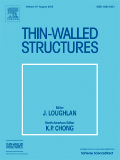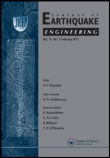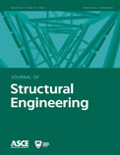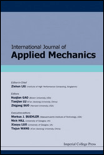
International Journal of Protective Structures
Scope & Guideline
Transforming protective structures for modern challenges.
Introduction
Aims and Scopes
- Blast and Impact Resistance:
Research on the behavior of various materials and structural configurations under blast and impact loading, including numerical modeling, experimental validation, and theoretical analysis. - Material Innovation:
Exploration of new materials and composites, such as fiber-reinforced polymers and auxetic structures, aimed at improving the protective capabilities of structures against dynamic threats. - Structural Design and Analysis:
Development of design methodologies and analytical frameworks for constructing and evaluating protective structures, with a focus on optimizing performance under extreme loading conditions. - Risk Assessment and Mitigation Strategies:
Investigation into risk evaluation techniques and mitigation strategies for minimizing damage and casualties in the event of explosive or impact incidents. - Interdisciplinary Approaches:
Integration of various scientific and engineering disciplines, including materials science, structural engineering, and computational modeling, to address complex challenges in protective structure design.
Trending and Emerging
- Machine Learning and Predictive Modeling:
There is a significant rise in the application of machine learning techniques for predicting blast loads and structural responses, indicating a shift towards data-driven methodologies that enhance predictive accuracy. - Advanced Computational Techniques:
Emerging computational methods, such as finite element analysis and arbitrary Lagrangian-Eulerian mapping, are increasingly utilized to simulate complex interactions during explosive events, showcasing the need for high-fidelity modeling. - Hybrid and Composite Materials:
A growing focus on hybrid materials and composite systems, such as fiber-reinforced concrete and auxetic structures, highlights the innovative strategies being explored to improve impact and blast resistance. - Real-Time Monitoring and Assessment:
The integration of real-time monitoring systems for assessing structural integrity during and after explosive events is gaining traction, emphasizing the importance of responsive and adaptive protective measures. - Explosive Safety and Risk Management:
Research addressing the safety and risk management of explosive materials, including field trials and probabilistic assessments, reflects an increased emphasis on proactive safety measures in protective engineering.
Declining or Waning
- Conventional Materials:
There is a noticeable decrease in studies focused solely on traditional construction materials like plain concrete and steel, as more innovative materials and composite systems gain attention for their enhanced performance. - Basic Analytical Models:
Research employing simple analytical models without considering complex interactions (e.g., non-linear effects, material degradation) is becoming less prevalent, as the field moves towards more sophisticated numerical simulations. - Static Loading Analysis:
The focus on static loading scenarios is waning in favor of dynamic analyses that better reflect the real-world conditions protective structures are designed to withstand. - Generalized Safety Assessments:
The trend of performing broad safety assessments without detailed context-specific evaluations is decreasing; researchers are now prioritizing tailored approaches that consider unique environmental and operational conditions.
Similar Journals

Bridge Structures
Innovating Design and Maintenance in Structural IntegrityBridge Structures is an esteemed academic journal dedicated to the field of structural engineering, particularly focusing on the design, analysis, and maintenance of bridge systems. Published by IOS PRESS, a reputable publisher known for its contributions to various scientific fields, the journal serves as an integral platform for disseminating innovative research and advancements within the domain. With an ISSN of 1573-2487 and an E-ISSN of 1744-8999, Bridge Structures has established itself over the years—covering contributions from 2005 to 2024. The journal has attained a commendable ranking within the Q3 category in Building and Construction and holds a position within the 28th percentile among its peers according to the Scopus rankings. Though the journal operates on a subscription basis, its commitment to advancing engineering knowledge is paramount, making it essential reading for researchers, practitioners, and students eager to deepen their understanding of bridge engineering. The journal not only explores theoretical advancements but also emphasizes practical applications, providing a well-rounded perspective on current challenges and solutions in the field of bridge structures.

THIN-WALLED STRUCTURES
Advancing the Future of Structural IntegrityTHIN-WALLED STRUCTURES is a premier international journal published by Elsevier Science Ltd, focusing on the critical areas of Building and Construction, Civil and Structural Engineering, and Mechanical Engineering. With an impressive impact factor and categorization in the Q1 quartile of each respective field, this journal stands at the forefront of engineering research, boasting commendable Scopus rankings—52nd for Mechanical Engineering, 18th for Building and Construction, and 32nd for Civil and Structural Engineering. Since its inception in 1983, THIN-WALLED STRUCTURES has provided a vital platform for disseminating innovative research, practical applications, and theoretical advancements in thin-walled structures, encouraging the development of safer and more efficient design methodologies. Although it operates on a traditional access model, the journal is committed to maintaining high-quality peer review and publishing, making it an essential resource for researchers, professionals, and students aiming to contribute to and benefit from the latest advancements in this dynamic field.

Structural Monitoring and Maintenance, An International Journal
Elevating standards in civil and structural engineering.Structural Monitoring and Maintenance, An International Journal is a prestigious publication dedicated to advancing knowledge in the fields of civil and structural engineering, as well as safety, risk, reliability, and quality assessment. Published by TECHNO-PRESS in South Korea, this journal serves as a vital platform for researchers, professionals, and students interested in the latest methodologies, technologies, and case studies pertaining to structural monitoring, assessment, and maintenance practices. With its current Q3 category ranking in both structural engineering and safety metrics, the journal aims to promote high-quality research that addresses real-world challenges in structural integrity and safety. As the journal converges its scope from 2014 to 2024, it continues to welcome innovative studies that contribute to the development of sustainable and resilient infrastructures worldwide. Despite the absence of an open-access option, the substantial readership is ensured through its indexed positions, currently ranked among the top journals in its field according to Scopus metrics. Engage with groundbreaking research that shapes the future of structural engineering and safety practices by delving into the contributions this journal offers.

JOURNAL OF EARTHQUAKE ENGINEERING
Transforming knowledge into practical solutions for seismic challenges.JOURNAL OF EARTHQUAKE ENGINEERING, published by TAYLOR & FRANCIS LTD, stands as a pivotal resource in the fields of Building and Construction, Civil and Structural Engineering, and Geotechnical Engineering. With an impressive Q1 ranking in multiple categories for 2023, this journal is instrumental for researchers, professionals, and students committed to advancing knowledge in earthquake engineering and its practical applications. As a platform that spans the years from 1997 to 2024, it highlights significant contributions to safety, risk, reliability, and quality in engineering practices. While the journal operates on a subscription basis, its highly regarded articles, bolstered by robust Scopus rankings—such as rank #46 in Building and Construction—underscore its credibility and influence in shaping standards and methodologies within the discipline. Promoting innovative and evidence-based approaches, the JOURNAL OF EARTHQUAKE ENGINEERING is essential reading for anyone engaged in the science and technology of earthquake-resistant structures.

STRUCTURAL SAFETY
Elevating standards in safety and risk management.STRUCTURAL SAFETY is a premier journal dedicated to advancing the field of engineering with a focus on safety, risk, reliability, and quality in structural analysis and design. Published by Elsevier, this esteemed journal boasts an impressive Impact Factor and ranks in the top quartiles (Q1) of key categories including Building and Construction, Civil and Structural Engineering, and Safety, Risk, Reliability, and Quality. With a significant history spanning from 1982 to 2024, STRUCTURAL SAFETY fosters scholarly exchange among researchers, professionals, and students by publishing innovative and high-quality research articles that contribute to the safety and resilience of engineered structures. The journal operates without open access barriers, ensuring a broad audience can access invaluable insights in the engineering realm. Its distinguished Scopus rankings further underscore its impactful role within the academic community, making it an essential resource for anyone invested in the discipline of structural safety.

Ingegneria Sismica
Advancing seismic safety through innovative research.Ingegneria Sismica, a premier journal published by PATRON EDITORE S R L, serves as an essential platform for the dissemination of research in the fields of building and construction, geotechnical engineering, and safety risk management. With a focus on earthquake engineering and structural safety, the journal has established itself as a prominent source of knowledge since its inception in 2010. The journal holds an impressive Q2 classification in multiple categories, including Building and Construction and Geotechnical Engineering, reflecting its significant impact within these disciplines. Despite its Italian roots, it appeals to an international audience of researchers, professionals, and students dedicated to advancing the understanding of seismic resilience and risk mitigation strategies. Although open access is not currently available, the potential for knowledge sharing and innovative methodologies presented in the articles continues to attract a robust readership. With its commitment to excellence and relevance, Ingegneria Sismica is poised to shape future discourse in engineering practices aimed at enhancing safety, reliability, and quality within seismic zones.

JOURNAL OF STRUCTURAL ENGINEERING
Elevating Standards in Structural EngineeringThe JOURNAL OF STRUCTURAL ENGINEERING, published by the ASCE-AMERICAN SOCIETY OF CIVIL ENGINEERS, is a premier academic journal that focuses on the latest advancements in the field of structural engineering. With a rich history dating back to 1955, this journal has become a crucial platform for disseminating peer-reviewed research that addresses critical issues and innovative solutions in building and construction, civil and structural engineering, materials science, and mechanics. It proudly holds a Q1 quartile ranking across multiple categories in the 2023 Scopus rankings, indicating its influential presence in the academic community. The journal does not currently offer open access options, ensuring that the content is rigorously vetted for quality and relevance, thus appealing to researchers, industry professionals, and students seeking credible, impactful research. With contributions from leading experts, the JOURNAL OF STRUCTURAL ENGINEERING is essential reading for anyone interested in advancing their understanding and practice within this vital area of engineering.

Earthquake Engineering and Engineering Vibration
Bridging research and application in earthquake engineering.Earthquake Engineering and Engineering Vibration, published by Springer, is a leading international journal dedicated to the field of earthquake engineering, structural dynamics, and the associated vibrational research integral to understanding and mitigating seismic risks. With its print ISSN 1671-3664 and E-ISSN 1993-503X, the journal operates from its headquarters in New York, USA. The journal has achieved a commendable Q2 category ranking across multiple engineering disciplines, reflecting its importance to the building and construction, civil and structural engineering, geophysics, geotechnical engineering, and mechanical engineering fields. The journal serves as a vital platform for researchers, practitioners, and students to disseminate their findings, share innovative methodologies, and contribute to advancements in earthquake resilience and engineering practices. Earthquake Engineering and Engineering Vibration is committed to fostering open dialogue and collaboration within the global research community, ensuring that its contributions are both impactful and relevant to contemporary challenges in engineering and environmental safety.

International Journal of Applied Mechanics
Fostering Collaboration in Applied Mechanics ResearchThe International Journal of Applied Mechanics, published by World Scientific Publishing Co Pte Ltd, is a premier platform that serves the fields of materials science, mechanical engineering, and mechanics of materials. Located in Singapore, this journal has established itself as a crucial resource for researchers, professionals, and students, with its convergence of scholarly work from 2009 to 2024. Ranked in the Q2 category across notable disciplines, including Materials Science, Mechanical Engineering, and Mechanics of Materials, it reflects a strong commitment to publishing high-quality research that pushes the boundaries of knowledge in applied mechanics. Despite being a non-open access journal, its successful Scopus rankings, including an impressive rank of #151 in Mechanical Engineering, signify its substantial impact and recognition within the academic community. This journal not only aims to disseminate pioneering research but also to foster collaboration and innovation in the rapidly evolving landscape of applied mechanics.

MECHANICS OF ADVANCED MATERIALS AND STRUCTURES
Illuminating the mechanics behind advanced materials and structures.Mechanics of Advanced Materials and Structures is a distinguished journal published by Taylor & Francis Inc, focusing on the innovative fields of Civil and Structural Engineering, Materials Science, Mechanical Engineering, and Mechanics of Materials. With ISSN 1537-6494 and E-ISSN 1537-6532, this journal is positioned within the Q2 quartile rankings of its categories, demonstrating its significant scholarly impact. It has been a pivotal platform since its inception in 1997, providing researchers and professionals with comprehensive insights and the latest findings, until the expected closure in 2024. Situated in the United Kingdom, the journal is dedicated to enhancing the understanding of complex materials and structural behavior through rigorous peer-reviewed articles. Its high visibility in Scopus rankings further underscores its importance, making it an essential resource for those engaged in advanced materials research and structural analysis. With options for open access, the journal ensures broad dissemination of knowledge, fostering a collaborative environment for researchers, practitioners, and students alike.